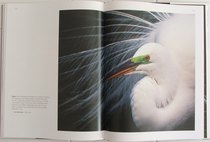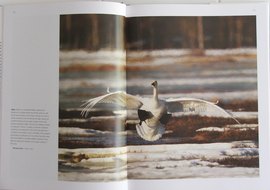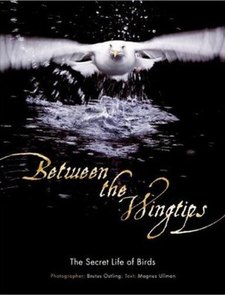Reviewed by Grant McCreary on April 23rd, 2008.
Between the Wingtips is a unique book. At first glance, it appears to be a standard photography showcase book. But after reading some of the captions, it becomes clear that it aspires to be more.
The book is divided into seven sections: The Flying Machine; The Life of Birds; Body and Plumage; Feeding; Habitats; Breeding; Migration and Distribution. Each consists of a one-page introduction, then a myriad of pictures, and their accompanying captions. The photos and captions work together to illustrate and describe aspects of a bird’s life and biology. For instance, the Feeding section shows birds with different types of bills, and the captions describe how each particular form is suited to obtaining specific food. The majority of the birds here are from Europe and North America, with some African and Antarctic subjects as well. There’s a good balance of the familiar and exotic.
 The photographs by Ostling are stunning and are reproduced nicely on good quality paper. Just about every style of photograph is included here. There are standard, full-body profile shots of some species, and close-up portraits of others. Among them are some of the most artistic and exquisite bird photographs that I’ve ever seen, such as the Little Blue Heron on page 87 and the Great Egret on 154-5, where the lighting and composition are used to brilliant effect. Others depict characteristic behavior. Perhaps the most spectacular capture a “frozen moment” view, such as the Long-tailed Duck running across water trying to get airborne, with drops of water like jewels suspended mid-air.
The photographs by Ostling are stunning and are reproduced nicely on good quality paper. Just about every style of photograph is included here. There are standard, full-body profile shots of some species, and close-up portraits of others. Among them are some of the most artistic and exquisite bird photographs that I’ve ever seen, such as the Little Blue Heron on page 87 and the Great Egret on 154-5, where the lighting and composition are used to brilliant effect. Others depict characteristic behavior. Perhaps the most spectacular capture a “frozen moment” view, such as the Long-tailed Duck running across water trying to get airborne, with drops of water like jewels suspended mid-air.
Though by no means comprehensive, the book does present a good introduction to many topics in ornithology and birding including molt, distribution, and even terms such as sympatric and allopatric (where similar birds have overlapping and non-overlapping ranges, respectively). Even very experienced birders will likely learn something new. In one photo, an African Harrier-hawk is shown perched on the side of a tree trunk with its wings and tail spread out. Without any explanation, anyone unfamiliar with these birds would assume that the photographer captured the raptor in a peculiar situation. However, the caption explains that this is how the bird forages – climbing trees with its tail and wings spread for balance. Who knew there were raptors that foraged like a creeper? Additionally, we learn that unlike other shorebirds, oystercatchers have to feed their chicks since the chicks are not yet able to open the shells of their preferred food, mollusks. While verifying this statement I found that not only is this so, but oystercatchers are the only birds in the world that have fully mobile (precocious) chicks, and yet the parents provide all their food until well after fledging.
The writing is generally adequate, but at times seemed a bit awkward. Sometimes I had to re-read sections because at first I didn’t understand what was being said (which, honestly, could be a failing on my part rather than the writing). There are also some questionable, and even incorrect, statements. The author claims that the reason birds sing more in the morning is because once their mates wake up they are too busy making sure they don’t “cheat” on them with other males. That may indeed be the case for some birds, but as far as I know, the prevailing theory is that early morning offers the best acoustics for sound, and thus that is when birds sing the most. Also, one caption suggests that all birds have two sets of plumage, including a nuptial one. However, plenty of birds, such as the Northern Cardinal, molt only once a year as adults and look the same throughout the year. Additionally, the text states that only juveniles grow all the feathers in a given tract simultaneously. That is true for most birds, but some ducks and most auks will molt all of their flight feathers at once. For these birds, the loss of even one or two primaries would make it difficult or impossible for them to fly. Thus, instead of the normal protracted molting of the wing feathers they do them all at once in order to minimize the time that they are flightless. Finally, even though it is somewhat ambiguous which birds can be considered “birds of prey”, it is generally assumed to include at least hawks, eagles, falcons, and their close relatives, and owls. This book, though, specifically excludes owls from this group, which could easily confuse some readers.
Recommendation
 The photographs alone would make this an easy book to recommend. And the use of the captions to teach about birds adds to its value. However, the errors and misconceptions in the text give me pause, and make me wonder if there are other problems that I didn’t catch. But then I consider the cases where the images and words work together magnificently, such as a head-on shot of a Whooper Swan about to land. The wings are spread wide and feet pushed forward in a breaking maneuver. In the midst of all the action, the viewer may overlook small feathers curled upward at the wrist joints of the wings. But the caption calls attention to these feathers, the alula, and explains how these small feathers play an integral role in the aerodynamics of flight. This synthesis of words and image work together to teach this subject so much better than any regular ornithological text could.
The photographs alone would make this an easy book to recommend. And the use of the captions to teach about birds adds to its value. However, the errors and misconceptions in the text give me pause, and make me wonder if there are other problems that I didn’t catch. But then I consider the cases where the images and words work together magnificently, such as a head-on shot of a Whooper Swan about to land. The wings are spread wide and feet pushed forward in a breaking maneuver. In the midst of all the action, the viewer may overlook small feathers curled upward at the wrist joints of the wings. But the caption calls attention to these feathers, the alula, and explains how these small feathers play an integral role in the aerodynamics of flight. This synthesis of words and image work together to teach this subject so much better than any regular ornithological text could.
Therefore, despite the flaws, Between the Wingtips is worth serious consideration. If you are a fan of bird photography, I daresay that you won’t be disappointed. And even though I would not recommend this book based on the text alone, there is some interesting stuff here and everyone can learn something from it.
Disclosure: I get a small commission for purchases made through links in this post.






I got this for $6 at Borders as a “Bargain Book”. It is indeed a bargain at this price, and easily worth it. So keep an eye out for it at your local bookstores.
I gave this book as a present to a friend. He really liked it. Amazing photographs.
In October there will be another book by the same author about Golden and White-tailed Eagles:
http://www.amazon.co.uk/Kingdom-Eagle-Brutus-Ostling/dp/140810704X
It’s already available in Swedish and has some great reviews.
http://www.brutusostling.se/english/aktuellt.html#ornar